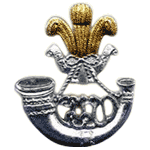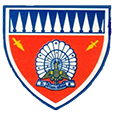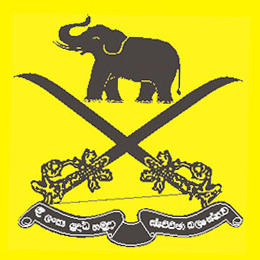
The Sri Lanka Armoured Corps (SLAC) provides the armour capability of the Sri Lanka Army, with vehicles such as the T-55AM2 main battle tank; the BMP infantry fighting vehicle; and the BTR-80 and WZ551 armoured personnel carriers. It comprises five regular armoured regiments, a volunteer regiment, and a regimental band. It has an independent Armoured Brigade and is headquartered at Rock House Army Camp, Colombo.
The Corp of Sri Lanka Engineers (SLE) is a combat support arm of the Sri Lanka Army which provides military engineering. It is made up of ten regular regiments and one volunteer regiment. Headquartered at Panagoda Cantonment, it is headed by the Centre Commandant.
The Sri Lanka Signals Corps (SLSC) is a combat support corps of the Sri Lanka Army, responsible for providing military communications, information technology and electronic warfare support. The corps is made up of a signals brigade, ten regular regiments and one volunteer regiment. It is responsible for installing, maintaining and operating all types of telecommunications equipment and information systems. It is headquartered at the Panagoda Cantonment.

The Sri Lanka Light Infantry (SLLI) is the oldest regiment in the Sri Lanka Army and the oldest infantry regiment in the army. It is made up of sixteen regular battalions and nine volunteer battalions, and is headquartered at the Panagoda Cantonment, Panagoda.

The Sri Lanka Sinha Regiment (SLSR) is an infantry regiment of the Sri Lanka Army; it is the second oldest infantry regiment in the army.

The Gajaba Regiment (GR) is an elite infantry regiment of the Sri Lankan Army. Formed on 14 October 1983 at the Saliyapura Camp in Anuradhapura, it is named after the famous Sinhalese King Gajabahu the First. It consists of 14 regular battalions and 6 volunteer battalions.

The Gemunu Watch (GW) ("King Dutugemunu's Own") is a infantry regiment of the Sri Lanka Army, formed with troops from the Ceylon Light Infantry and the Ceylon Sinha Regiment in 1962. It has been deployed in many major operations against the LTTE. It is made up of 14 regular units and 9 volunteer units. Headquartered at Kuruwita Army Camp, Ratnapura. It is named after one of the most famous Lankan Kings, King Dutugemunu.

The Sri Lanka Army Volunteer Force (SLAVF) is the active-duty volunteer reserve force of the Sri Lanka Army. The SLAVF is separate from the Regular Force which consists of personal who are professional soldiers and its Regular Reserve, which comprises personal who have a mobilization obligation following their service in the regular army. The SLAVF consists of the volunteer force and the volunteer reserve; administration and recruitment of reserve personal is carried out by the Volunteer Force Headquarters in Shalawa, Kosgama which is headed by the Commandant of the Volunteer Force. It has a current strength of about 55,000 personnel. The SLAVF was known as the Ceylon Volunteer Force from 1949 to 1972 and the Sri Lanka Volunteer Force from 1972 to 1985.
Colonel Aslam Fazly Laphir, PWV, RWP, RSP, SF was a Sri Lankan Army officer and posthumous recipient of the Parama Weera Vibhushanaya (PWV). He was awarded the PWV for his actions leading the 1st Special Forces Regiment during the Battle of Mullaitivu in which he was killed. Colonel Laphir played a major role in the formation and development of the Special Forces Regiment from the original Combat Tracker Team.
Lieutenant Colonel Prasanna Wickramasuriya, WWV, RWP, RSP is a highly decorated (retired) Sri Lanka Army officer who served as Chairman of Airport and Aviation Services Ltd. As a two-time recipient of the Weera Wickrama Vibhushanaya (WWV), the highest wartime military decoration awarded non-posthumously by Sri Lanka, Wickramasuriya is one of the most highly decorated Sri Lankan military officers.
General Shantha H.S. Kottegoda, WWV, RWP, RSP, VSV, USP is a retired senior Sri Lanka Army officer. He was the seventeenth commander of the Sri Lankan Army from 1 July 2004 – 5 December 2005. He had served as the Sri Lankan Ambassador to Brazil and Thailand. In April 2019, following the Easter Sunday bombings he was appointed as the permanent secretary to the Ministry of Defence.
G. D. H. Kamal Gunaratne, WWV, RWP, RSP, USP is a retired Sri Lankan army general. He is the Secretary to the Ministry of Defence and the State Ministry of National Security and Disaster Management. A retired career officer of the Sri Lanka Army, Gunaratne had served as the former Commander Security Forces Headquarters - Wanni, general officer commanding (GOC), 53 Division and was a former Deputy Ambassador to Brazil. He was the GOC of the 53 Division which killed the LTTE leader Velupillai Prabhakaran at Nandikadal, Mullaitivu.

General L. D. E. Cecil Waidyaratne, VSV, USP was a Sri Lanka Army general. He was 12th Commander of the Sri Lankan Army and a former Sri Lankan Ambassador to Thailand.
General Gerard Hector "Gerry" de Silva, RWP, VSV, USP was a senior Sri Lanka Army officer. He is the 5th Chancellor of General Sir John Kotelawala Defence University since 20 January 2020. He was the 13th Commander of the Sri Lankan Army and Sri Lankan High Commissioner to Pakistan.

Colonel Candauda Arachchige Dharmapala, OBE, ED was a Sri Lankan politician. He was a Parliamentary Secretary to the Minister of Industries, Housing and Social Services and Member of Parliament for Hakmana. He also served as the permanent secretary to the Ministry of Defence, and as Security Adviser to President J. R. Jayewardene.
Brigadier John Fredrick Halangode, VSV was a Sri Lankan army officer. He founded of the Gemunu Watch, having served as the first commanding officer of the 1st Battalion, Gemunu Watch.
Colonel Derrick Nugawela was a Sri Lankan army officer, planter and banker.
Colonel Sooriyaratne Douglas Ratwatte, ED was a Sri Lankan army officer. He was the Commandant of the Volunteer Force.
Major General A. K. Sumedha Perera, WWV, RWP, RSP, USP is a retired Sri Lankan general. He is the Permanent Secretary to the Ministry of Mahaweli, Agriculture, Irrigation and Rural Development; and former Deputy Chief of Staff of the Sri Lanka Army.
Colonel Alan Tollence Nugawela (19??-2007) was a Sri Lankan army officer and a planter.







